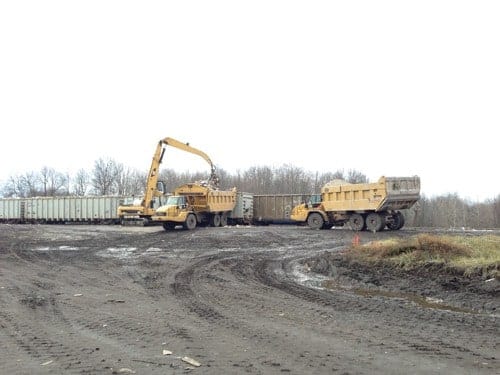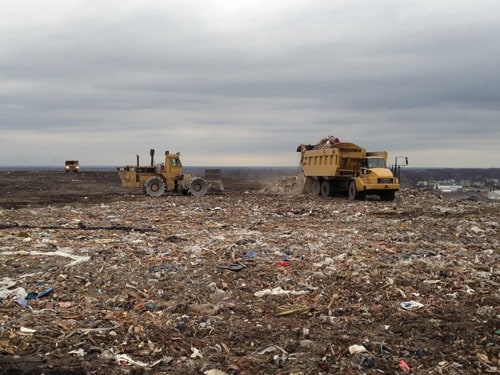The importance of spec’ing a haul truck to a landfill’s operation.
By Josh Swank
For refuse hauling, the volumetric capacity of standard truck bodies can limit landfills’ productivity. To get the most out of a truck, it’s important to consider the size and type of equipment used for loading, an operation’s haul cycles and the materials being hauled.
Sizing a Truck Body
 Standard bodies for off-highway trucks can be inefficient for landfills due to their restrictive volumetric capacity. Whether a landfill is hauling MSW or CDW, the average material densities for both of those types of refuse is substantially lighter than the “general purpose material” OEMs calculate when designing the stock bodies that come with the haul truck. For example, a traditional dump body that is on a 40-ton articulated hauler has a volumetric capacity of about 34 cubic yards at a 2:1 heap. If the refuse being hauled within the landfill has a material density of 650 pounds a cubic yard, the operator would only be able to haul about 11 tons, or 27.5 percent of the off-highway truck’s hauling capacity.
Standard bodies for off-highway trucks can be inefficient for landfills due to their restrictive volumetric capacity. Whether a landfill is hauling MSW or CDW, the average material densities for both of those types of refuse is substantially lighter than the “general purpose material” OEMs calculate when designing the stock bodies that come with the haul truck. For example, a traditional dump body that is on a 40-ton articulated hauler has a volumetric capacity of about 34 cubic yards at a 2:1 heap. If the refuse being hauled within the landfill has a material density of 650 pounds a cubic yard, the operator would only be able to haul about 11 tons, or 27.5 percent of the off-highway truck’s hauling capacity.
Custom refuse bodies can also be designed to meet unique challenges posed by different landfills. From tunnels and overhead obstacles to the specific loading equipment and conditions, each of these site-specific requirements needs to be taken into consideration when designing haulage equipment for handling large volumes of material. For example, the width and height of the truck bodies are engineered to work with different loading equipment. Sizing a truck body to complement the bucket capacity and length of a loader can help prevent spillage and maximize the equipment’s capability.
 Boosting Efficiency
Boosting Efficiency
Because a wide range of materials are disposed of at landfills, high-volume truck bodies are built with abrasion-resistant steel, which provides a longer life than the type of steel used in traditional-capacity dump bodies. Depending on the materials being hauled, operations also may choose to add special liners to the floor and corners of the body so refuse doesn’t get stuck as it’s off-loaded. These small details go a long way in boosting the efficiency, overall productivity and longevity of a haul truck body.
Rear-Eject Refuse Bodies
Beyond the liners, rear-eject refuse bodies, which push material out with a blade while leaving the truck bed down, can enhance productivity. Because the dumping site on landfills is changing by the load, the footing is often soft and uneven; rear-eject refuse bodies keep the center of gravity low while pushing the material out. The bed never raises, thus providing a safer alternative to end dump bodies in these environments. Additionally, ejector bodies also save time during the dumping cycle as the operators are able to eject the refuse “on the fly” while driving and head back to be reloaded without needing to wait for the truck bed to lower before moving on. Plus, the material is naturally distributed over a greater area than an end dump can provide, which minimizes compactor time on top of the active cell, providing additional efficiencies to the operation.
Versatility of equipment is ideal in any off-highway material haulage application. Whenever an operation can use their equipment for more than one use, they gain efficiency. As most landfills are required to cap the material hauled into the landfill with daily cover, having an ejector body can provide additional flexibility of spreading the daily cover over an area, thus reducing dozer time. When paired with a material spreader, rock, dirt or any other flowing material that is 2 inches or less in size can be broadcast from the back of an ejector body up to 60 feet in distance, providing a safe way of covering refuse that’s open to the elements on the side of a steep grade. For efficient waste management haulage using off-highway trucks, this customized option may be more efficient compared to standard truck bodies.
From volumetric limitations and abrasive materials, to the unique challenges of individual jobsites, custom truck bodies continue to demonstrate exceptional value for landfills and waste management.
Josh Swank, Vice President of Sales and Marketing, is a 16-year Philippi-Hagenbuch (Peoria, IL) associate. He oversees the sales group, specializing in the refuse industry and all company marketing efforts. His previous roles within the organization include global Sales and Marketing Manager, and Account Manager. Philippi-Hagenbuch Inc. has been building equipment for off-highway haul trucks since 1969 and has become a global leader in off-highway truck customization. The company designs and builds custom HiVol® specialty bodies, rear eject bodies, tailgates, sideboards, lowboy trailers and water tanks for nearly every make and model of rigid frame and articulated off-highway truck available. For more information, visit www.philsystems.com.
